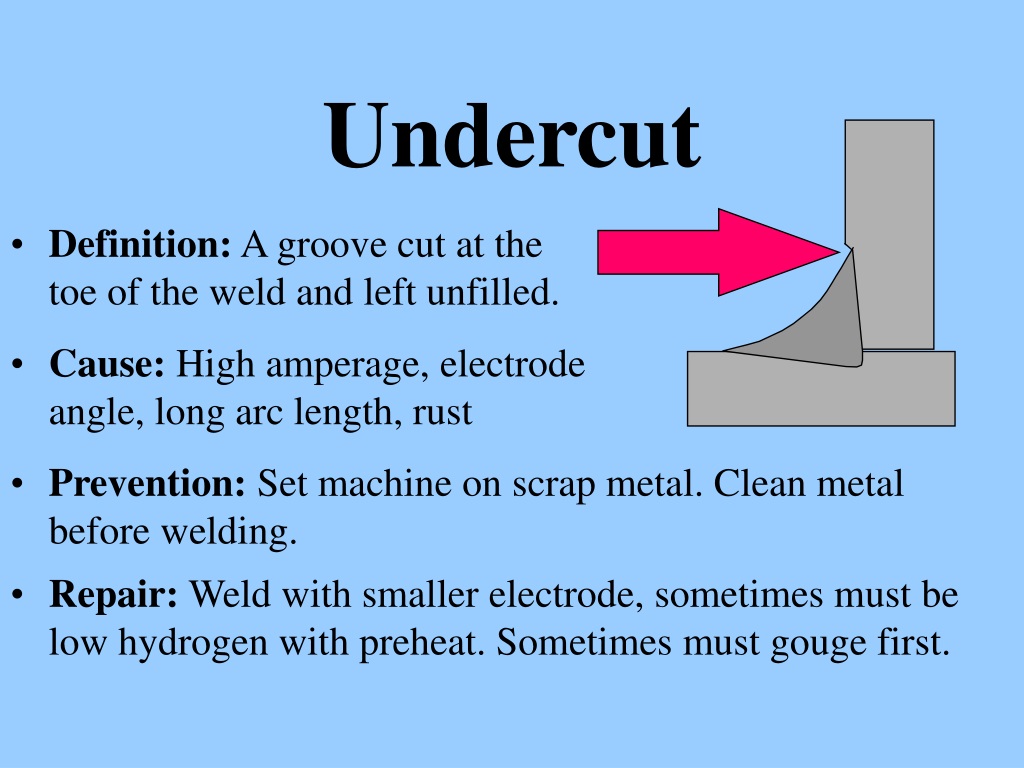Preventing Weld Undercut Demystified: Techniques for Success
Preventing Weld Undercut Demystified: Techniques for Success
Blog Article
A Comprehensive Overview to Identifying, Stopping, and Repairing Undercut Welding Issues in Your Welding Jobs
In the realm of welding, coming across undercut problems is a common challenge that can endanger the architectural honesty and overall quality of your welding tasks. Comprehending the root triggers behind undercut welding, being able to accurately detect it in your welds, and applying reliable preventative actions are vital skills for any welder. In addition, having the expertise and techniques to rectify undercut problems when they do take place can make a substantial difference in the last result of your welding undertakings. Stay tuned as we discover the vital components of recognizing, avoiding, and fixing undercut welding problems, supplying you with valuable understandings and methods to boost your welding skills to the next level.
Usual Sources Of Undercut Welding
Undercut welding, a common problem in welding processes, can be triggered by different elements that require to be carefully determined and addressed to guarantee the stability of the weld joint. One of the key reasons of undercut welding is extreme warm input.
Another common reason of undercut welding is incorrect welding strategy. Recognizing these root causes and carrying out rehabilitative actions is necessary in stopping and correcting undercut welding issues in welding jobs.
Identifying Undercut in Welds

To determine undercut precisely, appropriate lighting and zoom devices are crucial to evaluate the weld joint completely. Making use of devices such as a welding gauge or a magnifying glass can assist in identifying also the tiniest undercut flaws. Furthermore, running a finger or a fingernail along the weld joint can sometimes disclose undercut, as the surface may feel uneven or have a dip where the undercut exists.
Safety Nets for Undercut
Having a deep understanding of the sources of undercut in welds enables the implementation of efficient safety nets to maintain weld quality and honesty. One crucial preventive action appertains weld joint preparation. Making certain that the sides are clean, without impurities, and correctly beveled can significantly reduce the likelihood of undercut (Preventing weld undercut). Additionally, choosing the appropriate welding specifications, such as voltage, existing, and travel speed, is essential. These settings need to be enhanced to stop too much warmth input, which can cause undercut development.
Strategies for Fixing Undercut

Boosting the welding existing or decreasing the travel speed can help fill up in the undercut. In addition, altering the welding technique from a push to a drag or vice versa can likewise aid reduce undercut.
One more technique is to utilize a weaving activity while welding to guarantee appropriate sidewall blend and fill in the undercut. By oscillating the welding arc from side to side within the weld joint, the welder can transfer more filler material into the undercut areas, effectively getting rid of the flaw.
Furthermore, grinding out the undercut and rewelding the joint can be a practical option for more serious undercut problems - Preventing weld undercut. This procedure involves eliminating the undercut area, preparing the base steel, and afterwards rewelding the joint with appropriate welding criteria and techniques to stop undercut from click to find out more repeating

Expert Tips for Avoiding Undercut
Utilizing proper welding methods and preserving control over crucial welding specifications are vital methods for welders aiming to protect against undercut in their weld joints. One specialist pointer for staying clear of undercut is to make sure appropriate joint preparation. This involves cleansing the base steel completely to remove any type of pollutants that could lead to damage formation. Additionally, selecting the appropriate welding procedure and filler metal for the specific application can assist protect against undercut. Welders need to likewise pay close attention to the welding existing and voltage settings, ensuring they are within the recommended array to prevent getting too hot and prospective undercut. Keeping a regular travel rate during the welding procedure is one more necessary suggestion to avoid undercut. By moving at a steady rate, welders can make certain appropriate blend and decrease the chance of undercut formation. Lastly, evaluating the weld bead after conclusion can help determine any type of indicators of undercut early on, enabling instant restorative action to be taken.
Verdict
In final thought, determining, avoiding, and repairing undercut welding issues in your welding tasks is critical for making certain solid and resilient welds. Preventing weld undercut. By recognizing the common root causes of undercut, being able to recognize it in welds, applying preventive measures, and using appropriate strategies for repairing undercut, you can prevent prospective problems and create high-quality welds. Adhering to expert tips for preventing undercut can assist you improve your welding abilities and create far better outcomes in your tasks
Undercut welding, a common issue in welding procedures, can be created by various variables that need to be meticulously determined and resolved to make certain the stability of the weld joint. Additionally, running a finger or a finger nail along the weld joint can occasionally expose undercut, as the surface may feel irregular or have a dip where the undercut exists.
Using appropriate welding methods and keeping control over vital welding specifications are important techniques for welders aiming to prevent undercut in their weld joints.In conclusion, recognizing, stopping, and dealing with undercut welding issues in your welding projects is essential for guaranteeing sturdy recommended you read and strong welds. By understanding the typical causes of undercut, being able to recognize it in welds, executing preventative procedures, and utilizing proper techniques for repairing undercut, you can avoid potential problems and produce top notch welds.
Report this page